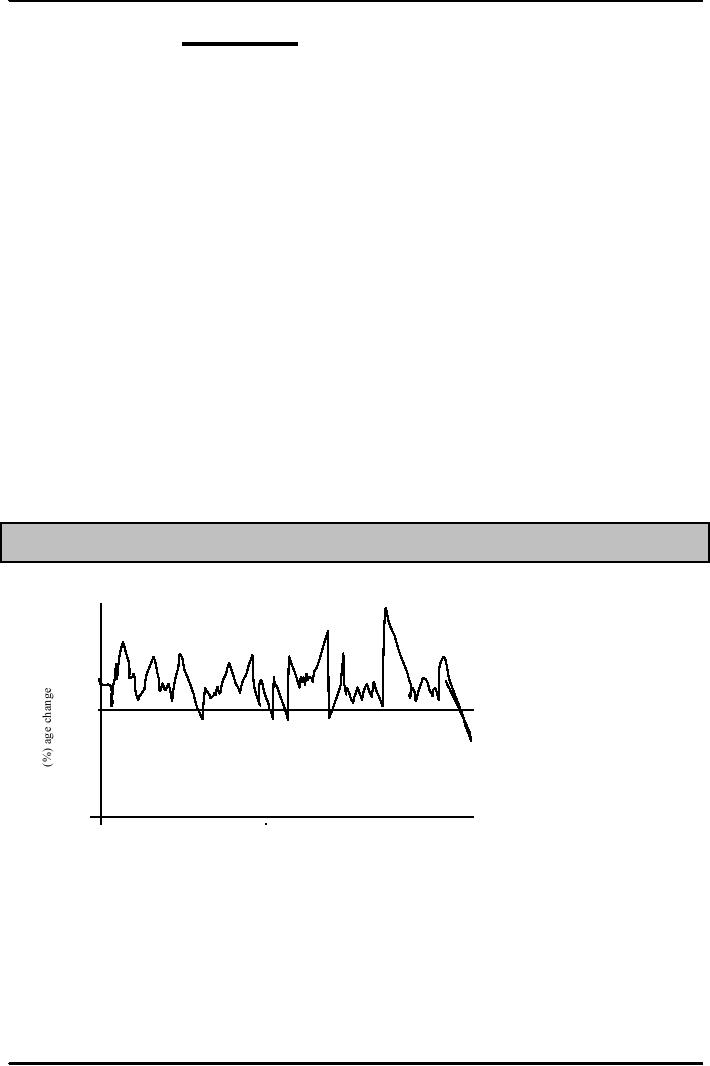 |
RISK AND VALUE OF STOCKS:The Theory of Efficient Markets |
| << VALUING STOCKS:Fundamental Value and the Dividend-Discount Model |
| ROLE OF FINANCIAL INTERMEDIARIES:Pooling Savings >> |

Money
& Banking MGT411
VU
Lesson
20
RISK
AND VALUE OF STOCKS
Stocks
Risk
and the Value of Stocks
Theory
of Efficient Markets
Investing
in Stocks for Long
Run
Stock
Markets' Role in the
Economy
Financial
Intermediation
Role
of Financial Intermediaries
Risk
and value of
stocks
The
dividend-discount model must be adjusted
to include compensation for a stock's
risk
Return
to Holding Stock for One
Year =
-
Ptoday
D
next
P
next
_
year
_
year
+
Ptoday
Ptoday
Since
the ultimate future sale
price is unknown the stock is
risky,
The
investor will require compensation in the
form of a risk
premium
Required
Stock Return (i) = Risk-free
Return (rf)
+ Risk Premium (rp)
The
risk-free rate can be thought of as the
interest rate on a treasury security with a
maturity of
several
months
Our
dividend discount model
becomes:
D
today
=
P
today
rf
+
rp
-
g
Risk
and value of
stocks
Stock
Prices are high
when
Current
dividends are high (Dtoday is
high)
Dividends
are expected to grow quickly (g is
high)
The
risk-free rate is low
(rf is
low)
The
risk premium on equity is
low (rp is
low)
The
S&P 500 index finished the
year 2003 at just over
1,100. was this level
warranted by
fundamentals?
Risk
free real interest rate is about 2% or
rf =
0.02
Risk
premium is assumed to be 4% or rp =
0.04
Dividend
growth rate is around 2% or g =
0.02
The
owner of a $1,000 portfolio
would have received $30 in
dividends during 2003
Substituting
the information in our adjusted dividend
discount model:
$30
Ptoday =
=
$750
0.02
+
0.04
- 0.02
But
the actual stock prices were substantially
higher than this calculated
figure
This
may be due to wrong assumption on
risk premium. The investors
may have been
demanding
lower risk premium in
2003.
To
compute it, we use the same
equation
65

Money
& Banking MGT411
VU
$30
1,10
=
-
0.02
(0.02+rp)
The
answer is approximately
2.75%
The
Theory of Efficient
Markets
The
basis for the theory of
efficient markets is the notion
that the prices of all
financial
instruments,
including stocks, reflect
all available
information
As
a result, markets adjust immediately and
continuously to changes in fundamental
values
When
markets are efficient, the
prices at which stocks
currently trade reflect all
available
information,
so that future price
movements are
unpredictable.
If
the theory is correct then no one
can consistently beat the
market average; active
portfolio
management
will not yield a return
that is higher than that of
a broad stock-market index
If
managers claim to exceed the
market average year after
year, it may be
because
They
must be taking on
risk,
They
are lucky,
They
have private information (which is
illegal), or
Markets
are not efficient
Investing
in Stocks for the Long
Run
Stocks
appear to be risky, and yet
many people hold substantial
proportions of their wealth
in
the
form of stock
This
is due to the difference between the short term and
the long term;
Investing
in stocks is risky only if
you hold them for a short
time
In
fact, when held for the
long term, stocks are less
risky than bonds.
Figure:
S&P 1-Year Stock Returns, 1871 to
2003(Returns are Real, Adjusted for
Inflation using
the
CPI)
60
40
20
0
-20
-40
-60
1895
1907
1919
1931
1943 1955
1871
1967
1883
197
1991
200
Years
66

Money
& Banking MGT411
VU
Figure:
S&P Long-Run Stock Returns, 1871 to
2003(Returns are Real, adjusted for
inflation
using
the CPI)
60
40
20
0
-20
-40
-60
1895
1907
1919
1931
1943 1955
1871
11883
1967
197
1991
200
____1-Year
Returns
____25
year Returns
The
Stock Market's Role in the
Economy
The
stock market plays a crucial
role in every modern capitalist
economy.
The
prices determined there tell us the
market value of companies,
which determines the
allocation
of resources.
Firms
with a high stock market
value are the ones
investors' prize, so they have an
easier time
garnering
the resources they need to
grow.
In
contrast, firms whose stock value is
low have difficulty financing
their operations
So
long as stock prices accurately reflect
fundamental values, this resource
allocation
mechanism
works well.
At
times, however, stock prices deviate
significantly from the fundamentals and
prices move in
ways
that are difficult to
attribute to changes in the real interest
rate, the risk premium, or the
growth
rate of future dividends.
The
Stock Market's Role in the
Economy
Shifts
in investor psychology may
distort prices; both euphoria and
depression are contagious
When
investors become unjustifiably exuberant
about the market's future
prospects, prices rise
regardless
of the fundamentals, and such mass
enthusiasm creates bubbles.
Bubbles
Bubbles
are persistent and expanding gaps between
actual stock prices and those warranted
by
the
fundamentals.
These
bubbles inevitably burst, creating
crashes.
They
affect all of us because
they distort the economic decisions
companies and
consumers
make
If
bubbles result in real investment
that is both excessive and
inefficiently distributed,
crashes
do
the opposite; the shift to excessive
pessimism causes a collapse in investment
and economic
growth
When
bubbles grow large enough and
result in crashes the stock market
can destabilize the
real
economy
Financial
Intermediation
Economic
well-being is essentially tied to the
health of the financial intermediaries
that make up
the
financial system.
67

Money
& Banking MGT411
VU
We
know that financial
intermediaries are the businesses
whose assets and liabilities
are
primarily
financial instruments.
Various
sorts of banks, brokerage firms,
investment companies, insurance
companies, and
pension
funds all fall into
this category.
These
are the institutions that
pool funds from people and
firms who save and lend them
to
people
and firms who need to
borrow
Financial
intermediaries funnel savers' surplus
resources into home
mortgages, business loans,
and
investments.
They
are involved in both
Direct
finance--in which borrowers
sell securities directly to lenders in the
financial markets
Indirect
finance--in which a third
party stands between those
who provide funds and those
who
use
them
Intermediaries
investigate the financial condition of
the individuals and firms who
want
financing
to figure out which have the
best investment
opportunities.
As
providers of indirect finance,
banks want to make loans
only to the highest-quality
borrowers.
When
they do their job correctly,
financial intermediaries increase
investment and economic
growth
at the same time that they
reduce investment risk and economic
volatility
Role
of Financial Intermediaries
As
a general rule, indirect finance
through financial intermediaries is
much more important
than
direct
finance through the stock and bond
markets
In
virtually every country for
which we have comprehensive data, credit extended by
financial
intermediaries
is larger as a percentage of GDP
than stocks and bonds
combined
Around
the world, firms and individuals
draw their financing
primarily from banks and
other
financial
intermediaries
The
reason for this is
information;
Just
think of an online
store
You
can buy virtually EVERYTHING
from $5 dinner plates to $300,000
sports car
But
you will notice an absence
of financial products, like student loans,
car loans, credit
cards
or
home mortgages
You
can not bonds on which
issuer is still making payments,
nor can you have the
services of
checking
account.
Why
such online store does
not deal in
mortgages?
Suppose
a company needs a mortgage of $100,000
and the store can (if at
all) establish a system
in
which 100 people sign up to
lend $1,000 each to the
company
But
the store has to do more
Collecting
the payments
Figuring
out how to repay the
lenders
Writing
legal contracts
Evaluating
the creditworthiness of the company and
feasibility of the mortgaged
project
Can
it do it all?
Financial
intermediaries exist so that
individual lenders don't have to worry
about getting
answers
to all of the important questions
concerning a loan and a
borrower
Lending
and borrowing involve transactions
costs and information costs, and
financial
intermediaries
exist to reduce these
costs
Financial
intermediaries perform five
functions:
1.
They
pool the resources of small
savers;
2.
They
provide safekeeping and accounting
services as well as access to the
payments
system;
3.
They
supply liquidity;
4.
They
provide ways to diversify risk;
and
5.
They
collect and process information in ways
that reduce information
costs
68
Table of Contents:
- TEXT AND REFERENCE MATERIAL & FIVE PARTS OF THE FINANCIAL SYSTEM
- FIVE CORE PRINCIPLES OF MONEY AND BANKING:Time has Value
- MONEY & THE PAYMENT SYSTEM:Distinctions among Money, Wealth, and Income
- OTHER FORMS OF PAYMENTS:Electronic Funds Transfer, E-money
- FINANCIAL INTERMEDIARIES:Indirect Finance, Financial and Economic Development
- FINANCIAL INSTRUMENTS & FINANCIAL MARKETS:Primarily Stores of Value
- FINANCIAL INSTITUTIONS:The structure of the financial industry
- TIME VALUE OF MONEY:Future Value, Present Value
- APPLICATION OF PRESENT VALUE CONCEPTS:Compound Annual Rates
- BOND PRICING & RISK:Valuing the Principal Payment, Risk
- MEASURING RISK:Variance, Standard Deviation, Value at Risk, Risk Aversion
- EVALUATING RISK:Deciding if a risk is worth taking, Sources of Risk
- BONDS & BONDS PRICING:Zero-Coupon Bonds, Fixed Payment Loans
- YIELD TO MATURIRY:Current Yield, Holding Period Returns
- SHIFTS IN EQUILIBRIUM IN THE BOND MARKET & RISK
- BONDS & SOURCES OF BOND RISK:Inflation Risk, Bond Ratings
- TAX EFFECT & TERM STRUCTURE OF INTEREST RATE:Expectations Hypothesis
- THE LIQUIDITY PREMIUM THEORY:Essential Characteristics of Common Stock
- VALUING STOCKS:Fundamental Value and the Dividend-Discount Model
- RISK AND VALUE OF STOCKS:The Theory of Efficient Markets
- ROLE OF FINANCIAL INTERMEDIARIES:Pooling Savings
- ROLE OF FINANCIAL INTERMEDIARIES (CONTINUED):Providing Liquidity
- BANKING:The Balance Sheet of Commercial Banks, Assets: Uses of Funds
- BALANCE SHEET OF COMMERCIAL BANKS:Bank Capital and Profitability
- BANK RISK:Liquidity Risk, Credit Risk, Interest-Rate Risk
- INTEREST RATE RISK:Trading Risk, Other Risks, The Globalization of Banking
- NON- DEPOSITORY INSTITUTIONS:Insurance Companies, Securities Firms
- SECURITIES FIRMS (Continued):Finance Companies, Banking Crisis
- THE GOVERNMENT SAFETY NET:Supervision and Examination
- THE GOVERNMENT'S BANK:The Bankers' Bank, Low, Stable Inflation
- LOW, STABLE INFLATION:High, Stable Real Growth
- MEETING THE CHALLENGE: CREATING A SUCCESSFUL CENTRAL BANK
- THE MONETARY BASE:Changing the Size and Composition of the Balance Sheet
- DEPOSIT CREATION IN A SINGLE BANK:Types of Reserves
- MONEY MULTIPLIER:The Quantity of Money (M) Depends on
- TARGET FEDERAL FUNDS RATE AND OPEN MARKET OPERATION
- WHY DO WE CARE ABOUT MONETARY AGGREGATES?The Facts about Velocity
- THE FACTS ABOUT VELOCITY:Money Growth + Velocity Growth = Inflation + Real Growth
- THE PORTFOLIO DEMAND FOR MONEY:Output and Inflation in the Long Run
- MONEY GROWTH, INFLATION, AND AGGREGATE DEMAND
- DERIVING THE MONETARY POLICY REACTION CURVE
- THE AGGREGATE DEMAND CURVE:Shifting the Aggregate Demand Curve
- THE AGGREGATE SUPPLY CURVE:Inflation Shocks
- EQUILIBRIUM AND THE DETERMINATION OF OUTPUT AND INFLATION
- SHIFTS IN POTENTIAL OUTPUT AND REAL BUSINESS CYCLE THEORY